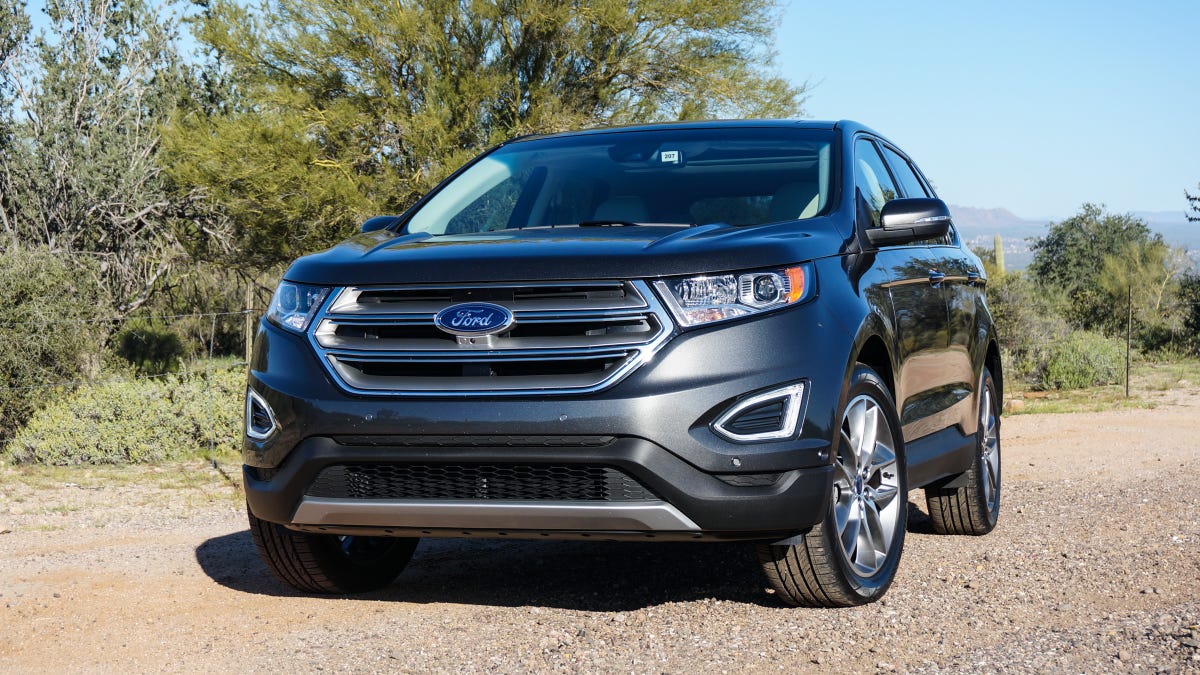2015 Ford Edge: new look, old tech (pictures)
We were pleased with all of the improvements to the 2015 Ford Edge, but disappointed to see that it's dashboard tech is, for now, unchanged.

2015 Ford Edge Titanium
The 2015 Ford Edge made its debut at the 2014 LA Auto Show with a new design and improved tech. I recently hit the road in the redesigned model.
2015 Ford Edge Titanium
The 2015 model still looks like an Edge, but the design is more muscular and athletic, where the previous models were significantly more angular and slab-sided.
2015 Ford Edge Titanium
The Edge's headlights still integrate into the automaker's three-bar grill.
2015 Ford Edge Titanium
I first experienced the new Edge behind the wheel of this Titanium trim level. The Edge is available in four trims: SE, SEL, Sport, and Titanium.
2015 Ford Edge Titanium
The new Edge is longer, but not wider than the outgoing model.
2015 Ford Edge Titanium
The tail lights feature a new horizontal design that echoes the rear end of the Fusion. An LED ribbon wraps around and connects the two corner clusters.
2015 Ford Edge Sport
The light ribbon spreads the pinpoint light of the LEDs out across the tail light surface.
2015 Ford Edge Titanium
The Edge's suspension has been tuned for smooth driving in urban environments. All wheel drive is optional; front drive is the default setup.
2015 Ford Edge Titanium
An optional front camera gives a 180-degree view of the area ahead and to the sides of the Edge. A camera washer cleans the lens whenever the windshield sprayer is activated.
2015 Ford Edge Titanium
Blind spot monitoring and rear cross traffic alert make reappearances in the Edge's safety tech suite.
2015 Ford Edge Titanium
A rear camera is standard on all Edge models. This camera does not feature a washer.
2015 Ford Edge Sport
The Edge Sport is more than just an appearance package, but it is visually unique in the lineup.
2015 Ford Edge Sport
The Sport model features black headlamp housings and dark trim for the grill.
2015 Ford Edge Sport
Large 20-inch wheels are shot with stickier tires, which work with the Sport's firmer suspension for better road handling.
2015 Ford Edge Sport
Ford tells me that there's no difference in the Sport's ride height, but to my eye it looks more hunkered down. That's likely due to the Sport's unique front end.
2015 Ford Edge Sport
Front and rear proximity sensors are joined by new side proximity sensors at the Edge's corners, providing full obstruction coverage for the vehicle's flank.
2.7L Ecoboost V6
The Edge Sport is the only trim level in the lineup that is powered by the new 2.7-liter EcoBoost V6 engine.
2.7L Ecoboost V6
Twin turbocharging boosts the engine's performance to the tune of 315 horsepower and 350 pound-feet of torque.
2015 Ford Edge Titanium
The rest of the Edge models are powered by the 2.0-liter EcoBoost four-cylinder or a naturally aspirated 3.5-liter V6.
2015 Ford Edge Titanium
The 2.0-liter EcoBoost engine is up to the task of moving the Edge down the road. It doesn't feel underpowered, but also isn't particularly inspired.
2015 Ford Edge Titanium
The Titanium model I was able to test was well-equipped with most of the available bells and whistles.
2015 Ford Edge Titanium
The media bin at the base of the center stack is deep enough to accommodate an iPhone 6 Plus and features an SD card slot for map data and a pair of full-speed, full-power USB ports.
2015 Ford Edge Titanium
The previous generation's dashboard made use of wonky capacitive buttons. The new model takes a step back and gives us traditional buttons and a big, chunky volume knob. Simpler is better.
2015 Ford Edge Titanium
Steering wheel controls feature a pair of directional pads that give the driver control over the SmartGauge instrumentation.
2015 Ford Edge Titanium
The panoramic sunroof opens up the cabin, letting gobs of light inside.
2015 Ford Edge Titanium
New to the Edge's bag of safety tricks is a Lane Departure Warning and Prevention system. This camera based system watches the lane markers and can intervene with the electric power steering to keep the car between the lines.
2015 Ford Edge Titanium
Ford's SmartGauge instrument cluster displays infotainment, fuel economy, and more between its two wing displays.
2015 Ford Edge Titanium
Push button start and entry is standard on higher trim levels. Interestingly the Edge also still makes use of Ford's keypad technology.
2015 Ford Edge Titanium
The all new 2015 Ford Edge isn't exactly "all new." The model still makes use of the older MyFord Touch 2 infotainment system.
2015 Ford Edge Titanium
Sync 3.0 will be available on the 2016 Edge, so tech savvy drivers may want to wait a model year.

